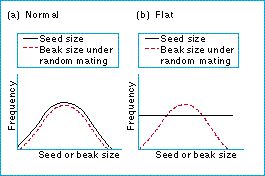Speciation - What are the major theories of speciation?

Sympatric speciation
Sympatric speciation describes the splitting into two of a species without any separation of the ancestral species' geographic range. Apart from hybrid speciation, which will be discussed later, it has been a source of recurrent controversy whether sympatric speciation ever happens.
Sympatric speciation could occurs as follows:
Imagine a bird species in which beak size determines the type of food the bird can eat. If the food is seeds, then there will be some distribution of seed sizes in the environment. Suppose also that there are several genotypes influencing beak size in the bird population. The fitnesses of the genotypes will be negatively frequency-dependent because as there are more birds with a certain size of beak they will compete with each other for food and lower one another's fitness. There will be a stable polymorphism of beak genotypes.
Provided the seed sizes have a flat distribution as in the figure, the different genotypes will not have equal fitness. Birds with extreme beak sizes will experience less competition for food, and have higher fitness. In this circumstance, selection will favor assortative mating (tendency of like to mate with like) for beak size. Birds at the edge of the distribution by mating assortatively would produce more offspring like themselves, and therefore with higher fitness, than if they mated at random. As selection fixes assortative mating, the population will split into two new species: one with long beaks, the other with short.
The general conditions for sympatric speciation are therefore that the genotypes are adapted to different resources and the limited resources generate frequency-dependent selection. Then if the resources are not in the frequencies of the genotypes generated by random mating, sympatric speciation becomes a possibility.
Figure: in (b) seed sizes have a flat distribution. Random mating among bird genotypes will produce too few birds with extreme beak sizes, and those birds will have a higher fitness because of reduced competition for food.
| Next |



